|
|
2009 Edition Chapter 2E. Guide Signs—Freeways and Expressways
Section 2E.01 Scope of Freeway and Expressway Guide Sign Standards
Support:
01 The provisions of this Chapter provide a uniform and effective system of signing for high-volume, high-speed motor vehicle traffic on freeways and expressways. The requirements and specifications for expressway signing exceed those for conventional roads (see Chapter 2D), but are less than those for freeway signing. Since there are many geometric design variables to be found in existing roads, a signing concept commensurate with prevailing conditions is the primary consideration. Section 1A.13 includes definitions of freeway and expressway.
02 Guide signs for freeways and expressways are primarily identified by the name of the sign rather than by an assigned sign designation. Guidelines for the design of guide signs for freeways and expressways are provided in the "Standard Highway Signs and Markings" book (see Section 1A.11).
Standard:
03 The provisions of this Chapter shall apply to any highway that meets the definition of freeway or expressway facilities.
Section 2E.02 Freeway and Expressway Signing Principles
Support:
01 The development of a signing system for freeways and expressways is approached on the premise that the signing is primarily for the benefit and direction of road users who are not familiar with the route or area. The signing furnishes road users with clear instructions for orderly progress to their destinations. Sign installations are an integral part of the facility and, as such, are best planned concurrently with the development of highway location and geometric design. For optimal results, plans for signing are analyzed during the earliest stages of preliminary design, and details are correlated as final design is developed. The excessive signing found on many major highways usually is the result of using a multitude of signs that are too small and that are poorly designed and placed to accomplish the intended purpose.
02 Freeway and expressway signing is to be considered and developed as a planned system of installations. An engineering study is sometimes necessary for proper solution of the problems of many individual locations, but, in addition, consideration of an entire route is necessary.
Guidance:
03 Road users should be guided with consistent signing on the approaches to interchanges, when they drive from one State to another, and when driving through rural or urban areas. Because geographical, geometric, and operating factors regularly create significant differences between urban and rural conditions, the signing should take these conditions into account.
04 Guide signs on freeways and expressways should serve distinct functions as follows:
- Give directions to destinations, or to streets or highway routes, at intersections or interchanges;
- Furnish advance notice of the approach to intersections or interchanges;
- Direct road users into appropriate lanes in advance of diverging or merging movements;
- Identify routes and directions on those routes;
- Show distances to destinations;
- Indicate access to general motorist services, rest, scenic, and recreational areas; and
- Provide other information of value to the road user.
Section 2E.03 Guide Sign Classification
Support:
01 Freeway and expressway guide signs are classified and treated in the following categories:
- Route signs and Trailblazer Assemblies (see Section 2E.27),
- At-Grade Intersection signs (see Section 2E.29),
- Interchange signs (see Sections 2E.30 through 2E.39),
- Interchange Sequence signs (see Section 2E.40),
- Community Interchanges Identification signs (see Section 2E.41),
- NEXT XX EXITS signs (see Section 2E.42),
- Weigh Station signing (see Section 2E.54),
- Miscellaneous information signs (see Section 2H.04),
- Reference Location signs (see Section 2H.05),
- General Service signs (see Chapter 2I),
- Rest and Scenic Area signs (see Section 2I.05),
- Tourist Information and Welcome Center signs (see Section 2I.08),
- Radio Information signing (see Section 2I.09),
- Carpool and Ridesharing signing (see Section 2I.11),
- Specific Service signs (see Chapter 2J), and
- Recreational and Cultural Interest Area signs (see Chapter 2M).
Section 2E.04 General
Support:
01 Signs are designed so that they are legible to road users approaching them and readable in time to permit proper responses. Desired design characteristics include: (a) long visibility distances, (b) large lettering, symbols, and arrows, and (c) short legends for quick comprehension.
Standard:
02 Standard shapes and colors shall be used so that traffic signs can be promptly recognized by road users.
Section 2E.05 Color of Guide Signs
Standard:
01 Guide signs on freeways and expressways, except as otherwise provided in this Manual, shall have white letters, symbols, arrows, and borders on a green background.
Support:
02 Color requirements for route signs and trailblazers, signs with blank-out or changeable messages, signs for services, rest areas, park and recreational areas, and for certain miscellaneous signs are provided in the individual Sections dealing with the particular sign or sign group.
Section 2E.06 Retroreflection or Illumination
Standard:
01 Letters, numerals, symbols, arrows, and borders of all guide signs shall be retroreflectorized. The background of all guide signs that are not independently illuminated shall be retroreflective.
Support:
02 Where there is no serious interference from extraneous light sources, retroreflectorized post-mounted signs usually provide adequate nighttime visibility.
03 On freeways and expressways where much driving at night is done with low-beam headlights, the amount of headlight illumination incident to an overhead sign display is relatively small.
Guidance:
04 Overhead sign installations should be illuminated unless an engineering study shows that retroreflectorization alone will perform effectively. The type of illumination chosen should provide effective and reasonably uniform illumination of the sign face and message.
Section 2E.07 Characteristics of Urban Signing
Support:
01 Urban conditions are characterized not so much by city limits or other arbitrary boundaries, as by the following features:
- Mainline roadways with more than two lanes in each direction;
- High traffic volumes on the through roadways;
- High volumes of traffic entering and leaving interchanges;
- Interchanges closely spaced;
- Roadway and interchange lighting;
- Three or more interchanges serving the major city;
- A loop, circumferential, or spur serving a sizable portion of the urban population; and
- Visual clutter from roadside development.
02 Operating conditions and road geometrics on urban freeways and expressways usually make special sign treatments desirable, including:
- Use of Interchange Sequence signs (see Section 2E.40);
- Use of sign spreading to the maximum extent possible (see Section 2E.11);
- Elimination of General or Specific Service signing (see Chapters 2I and 2J);
- Reduction to a minimum of post-interchange signs (see Section 2E.38);
- Display of advance signs at distances closer to the interchange, with appropriate adjustments in the legend (see Section 2E.33);
- Use of overhead signs on roadway structures and independent sign supports (see Section 2E.25);
- Use of Overhead Arrow-per-Lane or Diagrammatic guide signs in advance of intersections and interchanges (see Sections 2E.21 and 2E.22); and
- Frequent use of street names as the principal message in guide signs.
03 Lower speeds which are often characteristic of urban operations do not justify lower signing standards. Typical traffic patterns are more complex for the road user to negotiate, and large, easy-to-read legends are, therefore, just as necessary as on rural highways.
Section 2E.08 Characteristics of Rural Signing
Support:
01 Rural areas ordinarily have greater distances between interchanges, which permits adequate spacing for the sequences of signs on the approach to and departure from each interchange. However, the absence of traffic in adjoining lanes and on entering or exiting ramps often adds monotony or inattention to rural driving. This increases the importance of signs that call for decisions or actions.
Guidance:
02 Where there are long distances between interchanges and the alignment is relatively unchanging, signs should be positioned for their best effect on road users. The tendency to group all signing in the immediate vicinity of rural interchanges should be avoided by considering the entire route in the development of signing plans. Extra effort should be given to the placement of signs at natural target locations to command the attention of the road user, particularly when the message requires an action by the road user.
Section 2E.09 Signing of Named Highways
Support:
01 Section 2D.53 contains information, which is also applicable to freeways and expressways, regarding the use of highway names on the signing for unnumbered highways to enhance route guidance and facilitate travel.
02 Section 2M.10 contains information regarding memorial signing of routes, bridges, or highway components.
Section 2E.10 Amount of Legend on Guide Signs
Guidance:
01 No more than two destination names or street names should be displayed on any Advance Guide sign or Exit Direction sign. A city name and street name on the same sign should be avoided. Where two or three signs are placed on the same supports, destinations or names should be limited to one per sign, or to a total of three in the display. Sign legends should not exceed three lines of copy, exclusive of the exit number and action or distance information.
Section 2E.11 Number of Signs at an Overhead Installation and Sign Spreading
Guidance:
01 If overhead signs are warranted, as set forth in Section 2A.17, the number of signs at these locations should be limited to only those essential in communicating pertinent destination information to the road user. Exit Direction signs for a single exit and the Advance Guide signs should have only one sign with one or two destinations. Regulatory signs, such as speed limits, should not be used in conjunction with overhead guide sign installations. Because road users have limited time to read and comprehend sign messages, there should not be more than three guide signs displayed at any one location either on the overhead structure or its support.
Option:
02 At overhead locations, more than one sign may be installed to advise of a multiple exit condition at an interchange. If the roadway ramp or crossing roadway has complex or unusual geometrics, additional signs with confirming messages may be provided to properly guide the road user.
Support:
03 Sign spreading is a concept where major overhead signs are spaced so that road users are not overloaded with a group of signs at a single location. Figure 2E-1 illustrates an example of sign spreading.
Figure 2E-1 Example of Guide Sign Spreading
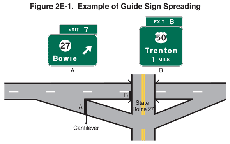
Guidance:
04 Where overhead signing is used, sign spreading should be used at all single exit interchanges and to the extent possible at multi-exit interchanges. Sign spreading should be accomplished by use of the following:
- The Exit Direction sign should be the only sign used in the vicinity of the gore (other than the Exit Gore sign). It should be located overhead near the theoretical gore and generally on an overhead sign support structure.
- The Advance Guide sign to indicate the next interchange exit should be placed near the crossroad location. If the crossroad goes over the mainline, the Advance Guide sign should be placed on the overcrossing structure or on a separate structure immediately in front of the overcrossing structure.
Section 2E.12 Pull-Through Signs (E6-2, E6-2a)
Support:
01 Pull-Through (E6-2, E6-2a) signs (see Figure 2E-2) are overhead guide signs intended for through traffic.
Figure 2E-2 Pull-Through Signs
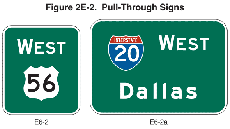
Guidance:
02 Pull-Through signs should be used where the geometrics of a given interchange are such that it is not clear to the road user as to which is the through roadway, or where additional route guidance is desired. Pull-Through signs with down arrows should be used where the alignment of the through lanes is curved and the exit direction is straight ahead, where the number of through lanes is not readily evident, and at multi-lane exits where there is a reduction in the number of through lanes.
Support:
03 Sections 2E.20 through 2E.24 contain information regarding the use of Overhead Arrow-per-Lane or Diagrammatic guide signs at multi-lane exits where there is a reduction in the number of through lanes and a through lane becomes an interior option lane for through or exiting traffic.
Section 2E.13 Designation of Destinations
Standard:
01 The direction of a freeway and the major destinations or control cities along it shall be clearly identified through the use of appropriate destination legends (see Section 2D.37). Successive freeway guide signs shall provide continuity in destination names and consistency with available map information. At any decision point, a given destination shall be indicated by way of only one route.
Guidance:
02 Control city legends should be used in the following situations along a freeway:
- At interchanges between freeways;
- At separation points of overlapping freeway routes;
- On directional signs on intersecting routes, to guide traffic entering the freeway;
- On Pull-Through signs; and
- On the bottom line of post-interchange distance signs.
Support:
03 Continuity of destination names is also useful on expressways serving long-distance or intrastate travel.
04 The determination of major destinations or control cities is important to the quality of service provided by the freeway. Control cities on freeway guide signs are selected by the States and are contained in the "Guidelines for the Selection of Supplemental Guide Signs for Traffic Generators Adjacent to Freeways, 4th Edition/Guide Signs, Part II: Guidelines for Airport Guide Signing/Guide Signs, Part III: List of Control Cities for Use in Guide Signs on Interstate Highways," published by and available from the American Association of State and Highway Transportation Officials (see Section 1A.11).
Section 2E.14 Size and Style of Letters and Signs
Standard:
01 Except as provided in Section 2A.11, the sizes of freeway and expressway guide signs that have standardized designs shall be as shown in Table 2E-1.
| Sign or Plaque | Sign Designation | Section | Minimum Size |
|---|---|---|---|
| Exit Number (plaque) | |||
| 1-, 2-Digit Exit Number | E1-5P | 2E.31 | 114 x 30 |
| 3-Digit Exit Number | E1-5P | 2E.31 | 132 x 30 |
| 1-, 2-Digit Exit Number (with single letter suffix) | E1-5P | 2E.31 | 138 x 30 |
| 3-Digit Exit Number (with single letter suffix) | E1-5P | 2E.31 | 156 x 30 |
| 1-, 2-Digit Exit Number (with dual letter suffix) | E1-5P | 2E.31 | 168 x 30 |
| 3-Digit Exit Number (with dual letter suffix) | E1-5P | 2E.31 | 186 x 30 |
| Left (plaque) | E1-5aP | 2E.33 | 72 x 30 |
| Left Exit Number (plaque) | |||
| 1-, 2-Digit Exit Number | E1-5bP | 2E.31 | 114 x 54 |
| 3-Digit Exit Number | E1-5bP | 2E.31 | 132 x 54 |
| 1-, 2-Digit Exit Number (with single letter suffix) | E1-5bP | 2E.31 | 138 x 54 |
| 3-Digit Exit Number (with single letter suffix) | E1-5bP | 2E.31 | 156 x 54 |
| 1-, 2-Digit Exit Number (with dual letter suffix) | E1-5bP | 2E.31 | 168 x 54 |
| 3-Digit Exit Number (with dual letter suffix) | E1-5bP | 2E.31 | 186 x 54 |
| Next Exit XX Miles (1 line) | - | 2E.34 | Varies x 24 |
| Next Exit XX Miles (2 lines) | - | 2E.34 | Varies x 36 |
| Exit Gore (no exit number) | E5-1 | 2E.37 | 72 x 60 |
| Exit Gore (with exit number) | |||
| 1-, 2-Digit Exit Number | E5-1a | 2E.37 | 78 x 60 |
| 3-Digit Exit Number | E5-1a | 2E.37 | 96 x 60 |
| 1-Digit Exit Number (with single letter suffix) | E5-1a | 2E.37 | 90 x 60 |
| 2-Digit Exit Number (with single letter suffix) | E5-1a | 2E.37 | 108 x 60 |
| 3-Digit Exit Number (with single letter suffix) | E5-1a | 2E.37 | 126 x 60 |
| 1-Digit Exit Number (with dual letter suffix) | E5-1a | 2E.37 | 120 x 60 |
| 2-Digit Exit Number (with dual letter suffix) | E5-1a | 2E.37 | 138 x 60 |
| 3-Digit Exit Number (with dual letter suffix) | E5-1a | 2E.37 | 156 x 60 |
| Exit Number (plaque) | |||
| 1-, 2-Digit Exit Number | E5-1bP | 2E.37 | 42 x 30 |
| 3-Digit Exit Number | E5-1bP | 2E.37 | 60 x 30 |
| 1-Digit Exit Number (with single letter suffix) | E5-1bP | 2E.37 | 48 x 30 |
| 1-Digit Exit Number (with dual letter suffix) | E5-1bP | 2E.37 | 72 x 30 |
| 2-Digit Exit Number (with single or dual letter suffix) |
E5-1bP | 2E.37 | 72 x 30 |
| 3-Digit Exit Number (with single or dual letter suffix) |
E5-1bP | 2E.37 | 72 x 30 |
| Narrow Exit Gore | E5-1c | 2E.37 | 60 x 90* |
| Pull-Through | E6-2 | 2E.12 | Varies x 120* |
| Pull-Through | E6-2a | 2E.12 | Varies x 90* |
| Exit Only (with arrow) | E11-1,1d | 2E.24 | 174** x 36 |
| Exit | E11-1a | 2E.24 | 66 x 18 |
| Only | E11-1b | 2E.24 | 66 x 18 |
| Exit Only | E11-1c | 2E.24 | 120 x 18 |
| Exit Only (with two arrows) | E11-1e,1f | 2E.24 | 222** x 36 |
| Left | E11-2 | 2E.40 | 60 x 18 |
| Exit Gore Advisory Speed (plaque) | E13-1P | 2E.37 | 72 x 24 |
| Exit Direction Advisory Speed | E13-2 | 2E.36 | 162 x 24 |
| Interstate Route Sign (1 or 2 digits) | M1-1 | 2E.27 | 36 x 36 |
| Interstate Route Sign (3 digits) | M1-1 | 2E.27 | 45 x 36 |
| Off-Interstate Route Sign (1 or 2 digits) | M1-2,3 | 2E.27 | 36 x 36 |
| Off-Interstate Route Sign (3 digits) | M1-2,3 | 2E.27 | 45 x 36 |
| U.S. Route Sign (1 or 2 digits) | M1-4 | 2E.27 | 36 x 36 |
| U.S. Route Sign (3 digits) | M1-4 | 2E.27 | 45 x 36 |
| State Route Sign (1 or 2 digits) | M1-5 | 2D.11 | 36 x 36 |
| State Route Sign (3 digits) | M1-5 | 2D.11 | 45 x 36 |
| County Route Sign (1, 2, or 3 digits) | M1-6 | 2D.11 | 36 x 36 |
| Forest Route (1, 2, or 3 digits) | M1-7 | 2D.11 | 36 x 36 |
| Eisenhower Interstate System | M1-10,10a | 2E.28 | 36 x 36 |
| Junction | M2-1 | 2D.13 | 30 x 21 |
| Combination Junction (2 route signs) | M2-2 | 2D.14 | 60 x 48* |
| Cardinal Direction | M3-1,2,3,4 | 2D.15 | 36 x 18 |
| Alternate | M4-1,1a | 2D.17 | 36 x 18 |
| By-Pass | M4-2 | 2D.18 | 36 x 18 |
| Business | M4-3 | 2D.19 | 36 x 18 |
| Truck | M4-4 | 2D.20 | 36 x 18 |
| To | M4-5 | 2D.21 | 36 x 18 |
| End | M4-6 | 2D.22 | 36 x 18 |
| Temporary | M4-7,7a | 2D.24 | 36 x 18 |
| Begin | M4-14 | 2D.23 | 36 x 18 |
| Advance Turn Arrow | M5-1,2,3 | 2D.26 | 30 x 21 |
| Lane Designation | M5-4,5,6 | 2D.27 | 36 x 24 |
| Directional Arrow | M6-1,2, 2a,3,4,5,6,7 | 2D.28 | 30 x 21 |
| Destination (1 line) | D1-1 | 2D.37 | Varies x 30 |
| Destination and Distance (1 line) | D1-1a | 2D.37 | Varies x 30 |
| Destination (2 lines) | D1-2 | 2D.37 | Varies x 54 |
| Destination and Distance (2 lines) | D1-2a | 2D.37 | Varies x 54 |
| Destination (3 lines) | D1-3 | 2D.37 | Varies x 72 |
| Destination and Distance (3 lines) | D1-3a | 2D.37 | Varies x 72 |
| Distance (1 line) | D2-1 | 2D.41 | Varies x 30 |
| Distance (2 lines) | D2-2 | 2D.41 | Varies x 54 |
| Distance (3 lines) | D2-3 | 2D.41 | Varies x 72 |
| Street Name | D3-1,1a | 2D.43 | Varies x 18 |
| Advance Street Name (2 lines) | D3-2 | 2D.44 | Varies x 42* |
| Advance Street Name (3 lines) | D3-2 | 2D.44 | Varies x 66* |
| Advance Street Name (4 lines) | D3-2 | 2D.44 | Varies x 84* |
| Park - Ride | D4-2 | 2D.48 | 36 x 48 |
| National Scenic Byways | D6-4 | 2D.55 | 24 x 24 |
| National Scenic Byways | D6-4a | 2D.55 | 24 x 12 |
| Weigh Station XX Miles | D8-1 | 2E.54 | 96 x 72 (F) 78 x 60 (E) |
| Weigh Station Next Right | D8-2 | 2E.54 | 108 x 90 (F) 84 x 72 (E) |
| Weigh Station (with arrow) | D8-3 | 2E.54 | 84 x 78 (F) 66 x 60 (E) |
| Crossover | D13-1,2 | 2D.54 | 78 x 42 |
| Freeway Entrance | D13-3 | 2D.46 | 48 x 30 |
| Freeway Entrance (with arrow) | D13-3a | 2D.46 | 48 x 42 |
| Combination Lane Use / Destination | D15-1 | 2D.33 | Varies x 96 |
| Next Truck Lane XX Miles | D17-1 | 2D.51 | 60 x 66 |
| Truck Lane XX Miles | D17-2 | 2D.51 | 60 x 54 |
| Slow Vehicle Turn-Out XX Miles | D17-7 | 2D.52 | 96 x 54 |
* The size shown is for a typical sign as illustrated in the figures in Chapters 2D and 2E. The size
should be determined based on the amount of legend required for the sign.
** The width shown represents the minimum dimension. The width shall be increased as appropriate to
match the width of the guide sign.
Notes:
- Larger signs may be used when appropriate
- Dimensions in inches are shown as width x height
- Where two sizes are shown, the larger size is for freeways (F) and the smaller size is for expressways (E)
Support:
02 Section 2A.11 contains information regarding the applicability of the various columns in Table 2E-1.
Option:
03 Signs larger than those shown in Table 2E-1 may be used (see Section 2A.11).
Standard:
04 For all freeway and expressway signs that do not have a standardized design, the message dimensions shall be determined first, and the outside sign dimensions secondarily. Word messages in the legend of expressway guide signs shall be in letters at least 8 inches high. Larger lettering shall be used for major guide signs at or in advance of interchanges and for all overhead signs. Minimum numeral and letter sizes for expressway guide signs according to interchange classification, type of sign, and component of sign legend shall be as shown in Tables 2E-2 and 2E-3. Minimum numeral and letter sizes for freeway guide signs according to interchange classification, type of sign, and component of sign legend shall be as shown in Tables 2E-4 and 2E-5. All names of places, streets, and highways on freeway and expressway guide signs shall be composed of lower-case letters with initial upper-case letters. The letters and the numerals used shall be Series E(M) of the "Standard Highway Signs and Markings" book (see Section 1A.11). The nominal loop height of the lower-case letters shall be 3/4 of the height of the initial upper-case letter (see Paragraph 2 of Section 2D.05 for additional information on the specification of letter heights). Other word legends shall be composed of upper-case letters. Interline and edge spacing shall be as provided in Section 2E.15.
| Type of Sign | Type of Interchange (see Section 2E.32) | Overhead | |||
|---|---|---|---|---|---|
| Major | Intermediate | Minor | |||
| Category a | Category b | ||||
| A. Advance Guide, Exit Direction, and Overhead Guide Signs | |||||
| Exit Plaques | |||||
| Words | 10 | 10 | 10 | 8 | 10 |
| Numerals & Letters | 15 | 15 | 15 | 12 | 15 |
| Interstate Route Signs | |||||
| Numerals | 18 | — | — | — | 18 |
| 1- or 2-Digit Shields | 36 x 36 | — | — | — | 36 x 36 |
| 3-Digit Shields | 45 x 36 | — | — | — | 45 x 36 |
| U.S. or State Route Signs | |||||
| Numerals | 18 | 18 | 18 | 12 | 18 |
| 1- or 2-Digit Shields | 36 x 36 | 36 x 36 | 36 x 36 | 24 x 24 | 36 x 36 |
| 3-Digit Shields | 45 x 36 | 45 x 36 | 45 x 36 | 30 x 24 | 45 x 36 |
| U.S. or State Route Text Identification (Example: US 56) | |||||
| Numerals & Letters | 18 | 15 | 15 | 12 | 15 |
| Cardinal Directions | |||||
| First Letters | 18 | 15 | 12 | 10 | 15 |
| Rest of Words | 15 | 12 | 10 | 8 | 12 |
| Auxiliary and Alternative Route Legends (Examples: JCT, TO, ALT, BUSINESS) | |||||
| Words | 15 | 12 | 10 | 8 | 12 |
| Names of Destinations | |||||
| Upper-Case Letters | 20 | 16 | 13.33 | 10.67 | 16 |
| Lower-Case Letters | 15 | 12 | 10 | 8 | 12 |
| Distance Numbers | 18 | 15 | 12 | 10 | 15 |
| Distance Fraction Numbers | 12 | 10 | 10 | 8 | 10 |
| Distance Words | 12 | 10 | 10 | 8 | 10 |
| Action Message Words | 10 | 10 | 10 | 8 | 10 |
| B. Gore Signs | |||||
| Words | 10 | 10 | 10 | 8 | — |
| Numerals & Letters | 12 | 12 | 12 | 10 | — |
Note: Sizes are shown in inches and where applicable are shown as width x height
| Type of Sign | Minimum Size |
|---|---|
| A. Pull-Through Signs | |
| Destinations — Upper-Case Letters | 13.33 |
| Destinations — Lower-Case Letters | 10 |
| Route Signs | |
| 1- or 2-Digit Shields | 36 x 36 |
| 3-Digit Shields | 45 x 36 |
| Cardinal Directions — First Letters | 12 |
| Cardinal Directions — Rest of Word | 10 |
| B. Supplemental Guide Signs | |
| Exit Number — Words | 8 |
| Exit Number — Numerals and Letters | 12 |
| Place Names — Upper-Case Letters | 10.67 |
| Place Names — Lower-Case Letters | 8 |
| Action Messages | 8 |
| Route Signs | |
| Numerals | 12 |
| 1- or 2-Digit Shield | 24 x 24 |
| 3-Digit Shield | 30 x 24 |
| C. Interchange Sequence or Community Interchanges Identification Signs | |
| Words — Upper-Case Letters | 10.67 |
| Words — Lower-Case Letters | 8 |
| Numerals | 10.67 |
| Fraction Numerals | 8 |
| Route Signs | |
| Numerals | 12 |
| 1- or 2-Digit Shield | 24 x 24 |
| 3-Digit Shield | 30 x 24 |
| D. Next XX Exits Sign | |
| Place Names — Upper-Case Letters | 10.67 |
| Place Names — Lower-Case Letters | 8 |
| NEXT XX EXITS — Words | 8 |
| NEXT XX EXITS — Number | 12 |
| E. Distance Signs | |
| Word — Upper-Case Letters | 8 |
| Word — Lower-Case Letters | 6 |
| Numeral | 8 |
| F. General Services Signs (see Chapter 2I) | |
| Exit Number — Words | 8 |
| Exit Number — Numerals and Letters | 12 |
| Services | 8 |
| G. Rest Area, Scenic Area, and Roadside Area Signs (see Chapter 2I) | |
| Words | 10 |
| Distance Numerals | 12 |
| Distance Fraction Numerals | 8 |
| Distance Words | 8 |
| Action Message Words | 10 |
| H. Reference Location Signs (see Chapter 2H) | |
| Words | 4 |
| Numerals | 10 |
| I. Boundary and Orientation Signs (see Chapter 2H) | |
| Words — Upper-Case Letters | 8 |
| Word — Lower-Case Letters | 6 |
| J. Next Exit and Next Services Signs | |
| Words and Numerals | 8 |
| K. Exit Only Signs | |
| Words | 12 |
| L. Overhead Arrow-Per-Lane and Diagrammatic Signs | |
| See Table 2E-5 |
Note: Sizes are shown in inches and where applicable are shown as width x height
| Type of Sign | Type of Interchange (see Section 2E.32) | Overhead | |||
|---|---|---|---|---|---|
| Major | Intermediate | Minor | |||
| Category a | Category b | ||||
| A. Advance Guide, Exit Direction, and Overhead Guide Signs | |||||
| Exit Number Plaques | |||||
| Words | 10 | 10 | 10 | 10 | 10 |
| Numerals & Letters | 15 | 15 | 15 | 15 | 15 |
| Interstate Route Signs | |||||
| Numerals | 24/18 | — | — | — | 18 |
| 1- or 2-Digit Shields | 48 x 48/ 36 x 36 |
— | — | — | 36 x 36 |
| 3-Digit Shields | 60 x 48/ 45 x 36 |
— | — | — | 45 x 36 |
| U.S. or State Route Signs | |||||
| Numerals | 24/18 | 18 | 18 | 12 | 18 |
| 1- or 2-Digit Shields | 48 x 48/ 36 x 36 |
36 x 36 | 36 x 36 | 24 x 24 | 36 x 36 |
| 3-Digit Shields | 60 x 48/ 45 x 36 |
45 x 36 | 45 x 36 | 30 x 24 | 45 x 36 |
| U.S. or State Route Text Identification (Example: US 56) | |||||
| Numerals & Letters | 18 | 18/15 | 15 | 12 | 15 |
| Cardinal Directions | |||||
| First Letters | 18 | 15 | 15 | 10 | 15 |
| Rest of Words | 15 | 12 | 12 | 8 | 12 |
| Auxiliary and Alternative Route Legends (Examples: JCT, TO, ALT, BUSINESS) | |||||
| Words | 15 | 12 | 12 | 8 | 12 |
| Names of Destinations | |||||
| Upper-Case Letters | 20 | 20 | 16 | 13.33 | 16 |
| Lower-Case Letters | 15 | 15 | 12 | 10 | 12 |
| Distance Numbers | 18 | 18/15 | 15 | 12 | 15 |
| Distance Fraction Numerals | 12 | 12/10 | 10 | 8 | 10 |
| Distance Words | 12 | 12/10 | 10 | 8 | 10 |
| Action Message Words | 12 | 12/10 | 10 | 8 | 10 |
| B. Gore Signs | |||||
| Words | 12 | 12 | 12 | 8 | — |
| Numerals &Letters | 18 | 18 | 18 | 12 | — |
Notes:
- Sizes are shown in inches and where applicable are shown as width x height
- Slanted line (/) signifies separation of desirable and minimum sizes
| Type of Sign | Minimum Size |
|---|---|
| A. Pull-Through Signs | |
| Destinations — Upper-Case Letters | 16 |
| Destinations — Lower-Case Letters | 12 |
| Route Signs | |
| 1- or 2-Digit Shields | 36 x 36 |
| 3-Digit Shields | 45 x 36 |
| Cardinal Directions — First Letter | 15 |
| Cardinal Directions — Rest of Word | 12 |
| B. Supplemental Guide Signs | |
| Exit Number Words | 10 |
| Exit Number Numerals and Letters | 15 |
| Place Names — Upper-Case Letters | 13.33 |
| Place Names — Lower-Case Letters | 10 |
| Action Messages | 8 |
| Route Signs | |
| Numerals | 12 |
| 1- or 2-Digit Shield | 24 x 24 |
| 3-Digit Shield | 30 x 24 |
| C. Interchange Sequence or Community Interchanges Identification Signs | |
| Words — Upper-Case Letters | 13.33 |
| Words — Lower-Case Letters | 10 |
| Numerals | 13.33 |
| Fraction Numerals | 10 |
| Route Signs | |
| Numerals | 12 |
| 1- or 2-Digit Shield | 24 x 24 |
| 3-Digit Shield | 30 x 24 |
| D. Next X Exits Sign | |
| Place Names — Upper-Case Letters | 13.33 |
| Place Names — Lower-Case Letters | 10 |
| NEXT X EXITS — Words | 10 |
| NEXT X EXITS — Number | 15 |
| E. Distance Signs | |
| Words — Upper-Case Letters | 8 |
| Words — Lower-Case Letters | 6 |
| Numerals | 8 |
| Route Signs | |
| Numerals | 9 |
| 1- or 2-Digit Shield | 18 x 18 |
| 3-Digit Shield | 22.5 x 18 |
| F. General Services Signs (see Chapter 2I) | |
| Exit Number Words | 10 |
| Exit Number Numerals and Letters | 15 |
| Services | 10 |
| G. Rest Area, Scenic Area, and Roadside Area Signs | |
| Words | 12 |
| Distance Numerals | 15 |
| Distance Fraction Numerals | 10 |
| Distance Words | 10 |
| Action Message Words | 12 |
| H. Reference Location Signs (see Chapter 2H) | |
| Words | 4 |
| Numerals | 10 |
| I. Boundary and Orientation Signs (see Chapter 2H) | |
| Wordd — Upper-Case Letters | 8 |
| Words — Lower-Case Letters | 6 |
| J. Next Exit and Next Services Signs | |
| Words and Numerals | 8 |
| K. Exit Only Signs | |
| Words | 12 |
| L. Overhead Arrow-Per-Lane Signs | |
| Arrowhead (Type D Directional Arrow) | 21.625 |
| Arrowhead Shaft Width | 8 |
| Arrow Height | |
| Through | 72 |
| Left Only | 48 |
| Right Only | 48 |
| Optional-Diverge (Through with Left or Right) | 72 |
| Optional-Split (Left and Right) | 66 |
| Vertical Separator Width | 2 |
| Vertical Space between Vertical Separator and Top of Nearest Arrow | 8 |
| Horizontal Space between Vertical Separator and Top of Nearest Through Arrow | 15 |
| Horizontal Space between Arrow Shaft and EXIT and ONLY Plaques | 10 |
| EXIT and ONLY Panels | 60 x 18 |
| M. Diagrammatic Signs | |
| Arrowhead (Type D Directional Arrow) | 13.5* |
| Lane Widths | 5 |
| Lane Line Segments | 1 x 6 |
| Spacing between Lane Line Segments | 6 |
| Stem Height to Upper Point of Departure | 30 |
| Horizontal Space between Arrowhead and Route Shield or Destination | 12 |
*The size shown is the arrowhead width per lane depicted on the corresponding arrow shaft
Note: Sizes are shown in inches and where applicable are shown as width x height
05 Lettering size on freeway and expressway signs shall be the same for both rural and urban conditions.
Support:
06 Sign size is determined primarily in terms of the length of the message and the size of the lettering necessary for proper legibility. Letter style and height, and arrow design have been standardized for freeway and expressway signs to assure uniform and effective application.
07 Designs for upper-case and lower-case alphabets together with tables of recommended letter spacing, are shown in the "Standard Highway Signs and Markings" book (see Section 1A.11).
Guidance:
08 Freeway lettering sizes (see Tables 2E-4 and 2E-5) should be used when expressway geometric design is comparable to freeway standards.
09 Other sign letter size requirements not specifically identified elsewhere in this Manual should be guided by these specifications. Abbreviations (see Section 2E.17) should be kept to a minimum.
Support:
10 A sign mounted over a particular roadway lane to which it applies might have to be limited in horizontal dimension to the width of the lane, so that another sign can be placed over an adjacent lane. The necessity to maintain proper vertical clearance might also place a further limitation on the size of the overhead sign and the legend that can be accommodated.
Section 2E.15 lnterline and Edge Spacing
Guidance:
01 Interline spacing of upper-case letters should be approximately three-fourths the average of upper-case letter heights in adjacent lines of letters.
02 The spacings to the top and bottom borders should be equal to the average of the letter height of the adjacent line of letters. The lateral spacing to the vertical borders should be essentially the same as the height of the largest letter.
Section 2E.16 Sign Borders
Standard:
01 Signs shall have a border of the same color as the legend in order to outline their distinctive shape and thereby give them easy recognition and a finished appearance.
Guidance:
02 For guide signs larger than 120 x 72 inches, the border should have a width of 2 inches. For smaller guide signs, a border width of 1.25 inches should be used, but the width should not exceed the stroke width of the lettering of the principal legend on the sign.
03 Corner radii of sign borders should be 1/8 of the minimum sign dimension on guide signs, except that the radii should not exceed 12 inches on any sign.
Option:
04 The sign material in the area outside of the corner radius may be trimmed.
Section 2E.17 Abbreviations
Guidance:
01 Abbreviations should be kept to a minimum; however, they are useful when complete destination messages produce excessively long signs. If used, abbreviations should be unmistakably recognized by road users (see Section 1A.15). Longer commonly used words that are not part of a proper name and are readily recognizable, such as Street, Boulevard, and Avenue, should be abbreviated to expedite recognition of the sign legend by reducing the amount and complexity of the legend.
02 Periods, apostrophes, question marks, ampersands, or other punctuation or characters that are not letters, numerals, or hyphens should not be used in abbreviations, unless necessary to avoid confusion.
03 The solidus (slanted line or forward slash) is intended to be used for fractions only and should not be used to separate words on the same line of legend. Instead, a hyphen should be used for this purpose, such as "CARS – TRUCKS."
Standard:
04 The words NORTH, SOUTH, EAST, and WEST shall not be abbreviated when used with route signs to indicate cardinal directions on guide signs.
Section 2E.18 Symbols
Standard:
01 Symbol designs shall be unmistakably like those shown in this Manual and in the "Standard Highway Signs and Markings" book (see Section 1A.11).
Guidance:
02 A special effort should be made to balance legend components for maximum legibility of the symbol with the rest of the sign.
Option:
03 Educational plaques may be used below symbol signs where needed.
Section 2E.19 Arrows for Interchange Guide Signs
Standard:
01 Arrows used on interchange guide signs shall be of the types shown in Figure 2D-2 and shall comply with the provisions of this Section and Section 2D.08.
02 Except on Overhead Arrow-per-Lane guide signs (see Section 2E.21) and on Exit Direction signs for lane drops (see Section 2E.24), and except as provided in Paragraphs 3 and 4, directional arrows on all overhead and post-mounted Exit Direction signs shall point diagonally upward and shall be located on the side of the sign consistent with the direction of the exiting movement.
Option:
03 On post-mounted Exit Direction signs that are located where a directional arrow to the side of the legend farthest from the roadway might create an unusually wide sign that limits the road user's view of the arrow, the directional arrow may be placed at the bottom portion of the sign, centered under the legend.
Standard:
04 Directional arrows on guide signs for multi-lane exits shall be positioned below the legend approximately over the center of each lane to which the arrow applies (see Figures 2E-4 and 2E-8).
05 On overhead signs where down arrows are used to indicate a lane to be followed, a down arrow shall be positioned approximately over the center of each lane and shall point vertically downward toward the approximate center of that lane. Down arrows shall be used only on overhead guide signs that restrict the use of specific lanes to traffic bound for the destination(s) and/or route(s) indicated by these arrows. Down arrows shall not be used unless an arrow can be located over and pointed to the approximate center of each lane that can be used to reach the destination displayed on the sign.
06 If down arrows are used, having more than one down arrow pointing to the same lane on a single overhead sign (or on multiple signs on the same overhead sign structure) shall not be permitted.
Support:
07 Directional and down arrows for use on guide signs are shown in Figure 2D-2. Detailed drawings and standardized sizes based on ranges of letter heights for these arrows are provided in the "Standard Highway Signs and Markings" book (see Section 1A.11). Information on the dimensions for arrows used in Overhead Arrow-per-Lane and Diagrammatic guide signing is also provided in the "Standard Highway Signs and Markings" book.
Section 2E.20 Signing for Option Lanes at Splits and Multi-Lane Exits
Support:
01 Some freeway and expressway splits or multi-lane exit interchanges contain an interior option lane serving both movements in which traffic can either leave the route or remain on the route, or choose either destination at a split, from the same lane.
Standard:
02 On freeways and expressways, either the Overhead Arrow-per-Lane or Diagrammatic guide sign designs as provided in Sections 2E.21 and 2E.22 shall be used for all multi-lane exits at major interchanges (see Section 2E.32) that have an optional exit lane that also carries the through route (see Figures 2E-4, 2E-5, 2E-8, and 2E-9) and for all splits that include an option lane (see Figures 2E-6 and 2E-10). Overhead Arrow-per-Lane or Diagrammatic guide signs shall not be used on freeways and expressways for any other types of exits or splits, including single-lane exits and splits that do not have an option lane.
Guidance:
03 The Overhead Arrow-per-Lane guide sign design (see Section 2E.21) should also be considered for multi-lane exits with an option lane at intermediate interchanges (see Section 2E.32) based on such factors as the extent of the need to optimize the mainline operation by maximizing the usage of the option lane, the extent of the period(s) of the day during which the exiting volumes warrant the multi-lane exit arrangement, and the nature of the traffic that primarily uses the option lane during the high-volume periods.
04 Signing for multi-lane exits at minor interchanges (see Section 2E.32) that have an optional exit lane or at intermediate interchanges that have an optional exit lane at which it has been determined that the Overhead Arrow-per-Lane guide sign design is not warranted should use a combination of conventional guide signing and regulatory lane-use signing, in accordance with the provisions of Section 2E.23.
Section 2E.21 Design of Overhead Arrow-per-Lane Guide Signs for Option Lanes
Support:
01 Overhead Arrow-per-Lane guide signs (see Figure 2E-3) are used where an option lane is present at freeway and expressway multi-lane exit interchanges and splits. They display an upward-pointing arrow above each lane that conveys the direction(s) of travel that the lane serves at the point of departure. At locations where an option lane is present at a multi-lane exit or split, Overhead Arrow-per-Lane guide signs have been shown to be superior to either conventional guide signs or Diagrammatic guide signs because they convey positive direction about which destination and direction each approach lane serves, particularly for the option lane, which is otherwise difficult to clearly sign.
Figure 2E-3 Overhead Arrow-per-Lane Guide Sign for a Multi-Lane Exit with an Option Lane
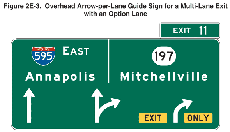
Standard:
02 Overhead Arrow-per-Lane guide signs shall be used on all new or reconstructed freeways and expressways as described in Section 2E.20.
03 Where used, the Overhead Arrow-per-Lane guide sign at the exit or split shall be located at or in the immediate vicinity of the point where the exiting lanes begin to diverge from the through lanes or, for a split, at the point where the approach lanes begin to diverge from one another, preserving the relation of the arrows displayed on the sign to their respective lanes. The Overhead Arrow-per-Lane guide sign at the exit shall not be located at or near the theoretical gore.
Option:
04 At existing or non-reconstructed locations where Exit Direction and Pull-Through signs exist at the theoretical gore, the existing sign support structure may remain in place, continuing to use Exit Direction and Pull-Through signs, in conjunction with a replacement of the advance signs using the Overhead Arrow-per-Lane guide sign design.
Standard:
05 If existing Exit Direction and Pull-Through signs are being retained at an interchange as provided in Paragraph 4, an Overhead Arrow-per-Lane guide sign shall not be used at the location of the Exit Direction and Pull-Through signs at or in the vicinity of the theoretical gore. New installations of Exit Direction and Pull-Through signs shall not be permitted in conjunction with Overhead Arrow-per-Lane guide signs on new or reconstructed facilities.
Guidance:
06 Overhead Arrow-per-Lane guide signs should be located at approximately 1/2 mile and 1 mile in advance of the exit or split, and at approximately 2 miles in advance of the exit or split where space is available and conditions allow.
Standard:
07 Overhead Arrow-per-Lane guide signs used on freeways and expressways shall include one arrow above each lane and shall be designed in accordance with the following criteria:
- The sign shall include an upward-pointing arrow for each lane of the approach to the split or exit, and the shaft of each arrow shall be located approximately over the center of the lane to which it applies.
- Arrows for continuing through lanes shall be vertically upward pointing (see Figure 2E-4) unless those lanes are on a significantly curved alignment beyond the theoretical gore, in which case the arrows for the continuing through lanes shall indicate the approximate degree of curvature (see Figure 2E-5).
- The arrow for a lane that must exit shall be curved in the direction of the exit and shall be accompanied by black-on-yellow EXIT (E11-1a) and ONLY (E11-1b) sign panels adjacent to the lower end of the arrow shaft. The E11-1a and E11-1b sign panels shall not be used for a split of two overlapping routes where neither of the diverging routes is designated as an exit. Where the through lanes curve and the exit continues on a straight alignment, upward-pointing vertical arrows shall be used for the exiting movement and curved arrows for the through movement.
- The arrow for an optional exit lane that also carries the through route shall have a single shaft that bifurcates into a vertically upward-pointing arrow and a curving arrow corresponding to the configuration of the through and exit lanes.
- For splits with an option lane, the arrow for the lane from which either direction of the split can be accessed shall have a single shaft that bifurcates into two upward-pointing curving arrows showing the approximate degrees of curvature of the two roadways beyond the theoretical gore (see Figure 2E-6).
- A vertical white line shall be used to separate the route shields and destinations for the two diverging movements from each other.
- The distance to the exit or split shall be displayed below the off-movement destination on the advance signs at the 1-mile and 2-mile locations.
- The number of lanes displayed on a sign shall correspond to the number of lanes at the location of that sign. An advance sign shall not depict lanes that are added downstream of a sign location.
- For numbered exits, the Exit Number (E1-5P) or Left Exit Number (E1-5bP) plaque shall be used at the top of the sign in accordance with Section 2E.31. For unnumbered left exits, the LEFT (E1-5aP) plaque shall be used at the top left edge of the sign.
Figure 2E-4 Overhead Arrow-per-Lane Guide Signs for a Two-Lane Exit to the Right with an Option Lane
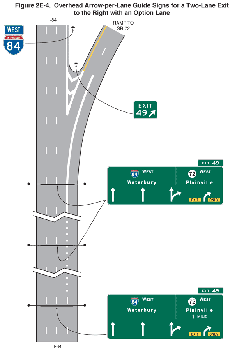
Figure 2E-5 Overhead Arrow-per-Lane Guide Signs for a Two-Lane Exit to the Right with an Option Lane (Through Lanes Curve to the Left)
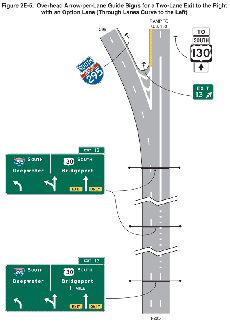
Figure 2E-6 Overhead Arrow-per-Lane Guide Signs for a Split with an Option Lane
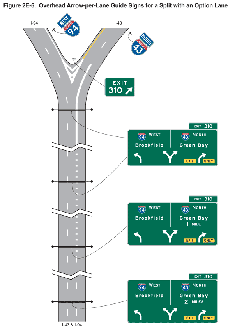
Guidance:
08 Overhead Arrow-per-Lane guide signs used on freeways and expressways should be designed in accordance with the following additional criteria:
- No more than one destination should be displayed for each movement, and no more than two destinations should be displayed per sign.
- The arrowhead(s) for the diverging movement should be positioned lower on the sign than the arrowhead(s) for the movement that continues straight ahead, independent of which movement carries the through route. Where the movements are freeway or expressway splits rather than exits, the arrowheads should be positioned at approximately the same height on the sign.
- Route shields, cardinal directions, and destinations should be positioned on the sign such that they are clearly related to the arrowhead(s) for the movement to which they apply.
- The cardinal direction should be placed adjacent to the route shield for exits or splits leading in a single cardinal direction.
- The vertical white line that is used to separate the route shields and destinations for the two diverging movements from each other should not descend below the top of the arrowheads for the through lanes, and should be positioned approximately halfway between the diverging arrowheads for the optional movement lane (see Figure 2E-3).
Standard:
09 Overhead Arrow-per-Lane guide signs shall not be used to depict a downstream split of an exit ramp on a sign located on the mainline.
Support:
10 Specific guidelines for more detailed design of Overhead Arrow-per-Lane guide signs are contained in the "Standard Highway Signs and Markings" book (see Section 1A.11).
Option:
11 Where extra emphasis of an especially low advisory ramp speed is needed, an EXIT XX MPH (E13-2) sign panel (see Figure 2E-27) may be placed below the applicable destination legend to supplement, but not to replace, the exit or ramp advisory speed warning signs.
Section 2E.22 Design of Freeway and Expressway Diagrammatic Guide Signs for Option Lanes
Support:
01 Diagrammatic guide signs (see Figure 2E-7) are guide signs that show a simplified graphic view of the exit arrangement in relationship to the main highway. While the use of such guide signs might be helpful for the purpose of conveying relative direction of each movement, Diagrammatic guide signs have been shown to be less effective than conventional or Overhead Arrow-per-Lane guide signs at conveying the destination or direction(s) that each approach lane serves, regardless of whether dedicated or option lanes are present.
Figure 2E-7 Diagrammatic Guide Sign for a Multi-Lane Exit with an Option Lane

Standard:
02 Diagrammatic guide signs used where an option lane is present at a freeway or expressway split or multi-lane exit shall be designed in accordance with the following criteria:
- The graphic legend shall be of a plan view showing the off-ramp arrangement.
- No other symbols or route shields shall be used as a substitute for arrowheads.
- They shall not be installed at the Exit Direction sign location (see Section 2E.36).
- The EXIT ONLY sign panel shall not be used on diagrammatic guide signs in advance of the interchange.
- For numbered exits, the Exit Number (E1-5P) or Left Exit Number (E1-5bP) plaque shall be used at the top of the sign in accordance with Section 2E.31. For unnumbered left exits, the LEFT (E1-5aP) plaque shall be used at the top left edge of the sign.
- The EXIT ONLY (E11-1e or E11-1f) sign panels shall be used on the Exit Direction sign at the theoretical gore, except at splits of two overlapping routes where neither of the routes is designated as an exit.
Guidance:
03 Diagrammatic guide signs used on freeways and expressways should be designed in accordance with the following additional criteria:
- The graphic should not depict deceleration lanes.
- No more than one destination should be displayed for each movement, and no more than two destinations should be displayed per sign.
- The arrowhead for the diverging movement should be positioned lower on the sign than the arrowhead for the movement that continues straight ahead, independent of which movement carries the through route (see Figures 2E-8 and 2E-9). Where the movements are freeway or expressway splits rather than exits, the arrowheads should be positioned at approximately the same height on the sign (see Figure 2E-10).
- Arrow shafts should contain lane lines.
- Route shields, cardinal directions, and destinations should be positioned on the sign such that they are clearly related to the arrowhead(s), and the arrowhead for the off movement should point toward the route shield for the off movement.
- For exits or splits leading in a single direction, the cardinal direction should be placed adjacent to the route shield, and the destination should be placed below the route shield and cardinal direction.
Figure 2E-8 Diagrammatic Guide Signs for a Two-Lane Exit to the Right with an Option Lane
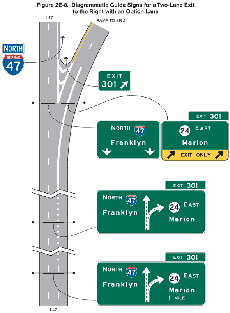
Figure 2E-9 Diagrammatic Guide Signs for a Two-Lane Exit to the Right with an Option Lane (Through Lanes Curve to the Left)
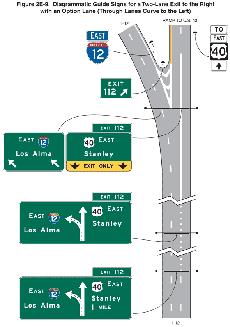
Figure 2E-10 Diagrammatic Guide Signs for a Split with an Option Lane
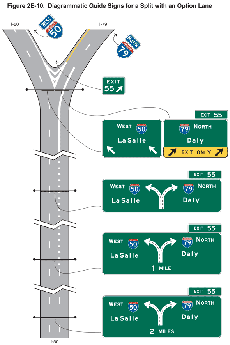
Standard:
04 Diagrammatic guide signs shall not be used at cloverleaf interchanges for the purpose of depicting successive departures from the mainline or separate downstream departures from a collector-distributor roadway. The use of Diagrammatic guide signs at cloverleaf interchanges shall be limited to the following cases:
- Where the outer (non-loop) exit ramp of the cloverleaf is a multi-lane exit having an optional exit lane that also carries the through route; and
- At cloverleaf interchanges that include collector-distributor roadways, such as those illustrated in Figure 2E-36, that are accessed from the mainline by a multi-lane exit having an optional exit lane that also carries the through route. In this case, the Diagrammatic guide sign shall only show the configuration of the lanes at the exit point to the collector-distributor roadway and not the entire interchange configuration.
Support:
05 Specific guidelines for more detailed design of Diagrammatic guide signs are contained in the "Standard Highway Signs and Markings" book (see Section 1A.11).
Option:
06 Where extra emphasis of an especially low advisory ramp speed is needed, an EXIT XX MPH (E13-2) sign panel (see Figure 2E-27) may be placed below the applicable destination legend to supplement, but not to replace, the exit or ramp advisory speed warning signs.
Section 2E.23 Signing for Intermediate and Minor Interchange Multi-Lane Exits with an Option Lane
Support:
01 Intermediate and minor multi-lane exits might have an operational need for the presence of an option lane for only the peak period during which excessive queues might otherwise develop if the option lane were not available. In such cases, the Overhead Arrow-per-Lane or Diagrammatic guide signing described for option lanes in Sections 2E.21 and 2E.22 might not be practical, depending on the level of use of the option lane and the spacing of nearby interchanges, particularly in non-rural areas.
Guidance:
02 Signing for an intermediate or minor interchange that has a multi-lane exit with an option lane that also carries the through route should use the same basic principles as those for a conventional exit. In such cases, the option lane is not signed on the Advance Guide signs. For such exits that involve the addition of an auxiliary lane that is not present at the Advance Guide sign locations, but do not involve a lane drop (see Figure 2E-12), a sequence of post-mounted or overhead-mounted Advance Guide signs should be used, located in accordance with the interchange classification (see Section 2E.32). The Exit Direction sign should be located at the theoretical gore and display a diagonally upward-pointing directional arrow above each lane that departs from the mainline alignment. The Exit Direction sign should not contain the EXIT ONLY legend.
03 For such interchanges that also have a lane drop (see Figure 2E-11), the Advance Guide and Exit Direction signs should follow the provisions of Section 2E.24. The Exit Direction sign should be located at the theoretical gore and should contain the EXIT ONLY (E11-1e) sign panel.
Figure 2E-11 Example of Signing for a Two-Lane Intermediate or Minor Interchange Exit with an Option Lane and a Dropped Lane
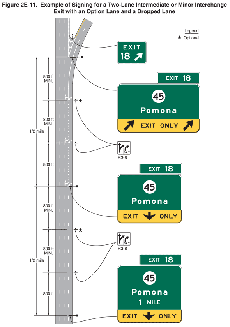
04 The presence of the option lane should be conveyed by the use of post-mounted lane-use (R3-8 Series) signs (see Section 2B.22). When used, the R3-8 signs should be of an appropriate size for their application to optimize their conspicuity. The signs should be located in succession with the Advance Guide signs, where the option and exit lanes have developed (see Figure 2E-11). In cases where the exiting lane or lanes have not developed and the option lane is created by the addition of an auxiliary lane that exits, the R3-8 signs should be located only adjacent to where the lanes have been fully developed and not in advance of the lane or along its transition (see Figure 2E-12).
Figure 2E-12 Example of Signing for a Two-Lane Intermediate or Minor Interchange Exit with Option and Auxiliary Lanes
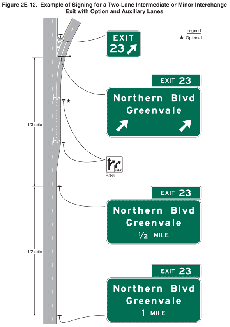
Support:
05 The use of a down arrow on overhead freeway or expressway guide signs has been shown to be misinterpreted by road users as an indication of a dedicated lane.
Standard:
06 Advance Guide signs that are mounted overhead shall not display a down arrow over an option lane.
Section 2E.24 Signing for Interchange Lane Drops
Standard:
01 The provisions of this Section shall only apply to lane drops at exits that do not have an optional exit lane. At exits that have an optional exit lane in addition to the dropped lane, the provisions of Sections 2E.20 through 2E.23 shall apply.
02 Major guide signs for all lane drops at interchanges shall be mounted overhead. An EXIT ONLY sign panel shall be used for all interchange lane drops at which the through route is carried on the mainline.
03 Except on Overhead Arrow-per-Lane and Diagrammatic guide signs (See Sections 2E.20 through 2E.22), the EXIT ONLY (down arrow) (E11-1 or E11-1f) sign panel (see Figure 2E-13) shall be used on all signing of lane drops on all overhead Advance Guide signs (see Figures 2E-14 through 2E-16). The number of arrows on each sign shall correspond to the number of dropped lanes at the location of each sign. Placement of the down arrow shall comply with the provisions of Section 2E.19.
Figure 2E-13 EXIT ONLY and LEFT Sign Panels
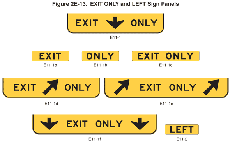
Figure 2E-14 Guide Signs for a Split with Dedicated Lanes
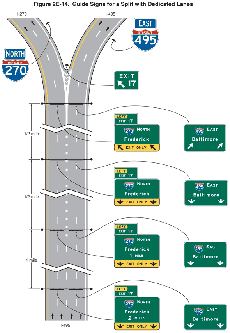
Figure 2E-15 Guide Signs for a Single-Lane Exit to the Left with a Dropped Lane
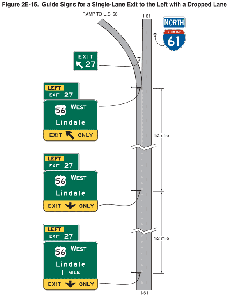
Figure 2E-16 Guide Signs for a Single-Lane Exit to the Right with a Dropped Lane
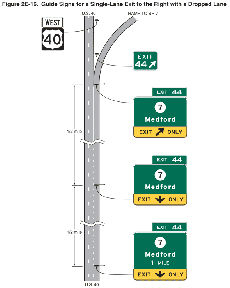
04 For lane drops, the Exit Direction sign (see Section 2E.36 and Figure 2E-26) shall be of the format shown in Figures 2E-15 and 2E-16. The bottom portion of the Exit Direction sign shall be yellow with a black border and shall include a diagonally upward-pointing black directional arrow (left or right) for each lane dropped at the exit, with the sign designed and placed so that each arrow is located over the approximate center of each lane being dropped. The words EXIT and ONLY shall be positioned to the left and right, respectively, of the arrow on the E11-1d sign panel for a single-lane drop. For a two-lane drop, the words EXIT ONLY shall be located between the two arrows on the E11-1e sign panel. The number of arrows on the sign shall correspond to the number of dropped lanes at the location of the sign.
Option:
05 EXIT ONLY messages of either the combination of E11-1a and E11-1b, or E11-1c formats may be used to retrofit existing signing to warn of a lane drop situation ahead.
Standard:
06 If used to retrofit an existing Advance Guide sign, the E11-1a and E11-1b sign panels (see Figure 2E-13) shall be placed on either side of a white down arrow. The E11-1c sign panel, if used to retrofit an existing sign, shall be placed between the lower destination message and the white down arrow.
Guidance:
07 Except as provided in Paragraph 8 for an auxiliary lane, Advance Guide signs for lane drops within 1 mile of the interchange should not contain the distance message.
08 Where the dropped lane is an auxiliary lane that is provided between successive entrance and exit ramps of two separate interchanges and the distance between the two ramps is less than 1 mile, the first Advance Guide sign in the sequence downstream from the entrance ramp should contain the distance message.
09 Wherever the dropped lane carries the through route, signs should be used without the EXIT ONLY sign panel.
Support:
10 Sections 2E.20 through 2E.23 contain information on the signing of lane drops at exits that also have an option lane.
11 Section 2B.23 contains information regarding regulatory signs that can also be used for freeway lane drop situations and Section 2C.42 contains information regarding warning signs that can also be used for freeway lane drop situations.
Section 2E.25 Overhead Sign Installations
Support:
01 Specifications for the design and construction of structural supports for signs have been standardized by the American Association of State Highway and Transportation Officials (AASHTO). Overcrossing structures can often serve for the support of overhead signs, and might in some cases be the only practical location that will provide adequate viewing distance. Use of these structures as sign supports will eliminate the need for additional sign supports along the roadside. Factors justifying the installation of overhead signs are given in Section 2A.17. Vertical clearance of overhead signs is discussed in Section 2A.18.
Section 2E.26 Lateral Offset
Standard:
01 The minimum lateral offset outside the usable roadway shoulder for post-mounted freeway and expressway signs or for overhead sign supports, either to the right-hand or left-hand side of the roadway, shall be 6 feet. This minimum clearance shall also apply outside of a curb. If located within the clear zone, the signs shall be mounted on crashworthy supports or shielded by appropriate crashworthy barriers.
Guidance:
02 Where practical, a sign should not be less than 10 feet from the edge of the nearest traffic lane. Large guide signs especially should be farther removed, preferably 30 feet or more from the nearest traffic lane.
03 Where an expressway median is 12 feet or less in width, consideration should be given to spanning both roadways without a center support.
04 Where overhead sign supports cannot be placed sufficiently far away from the line of traffic or in an otherwise protected site, they should either be designed to minimize the impact forces, or be adequately shielded by a traffic barrier of suitable design.
Standard:
05 Butterfly-type sign supports and other overhead non-crashworthy sign supports shall not be installed in gores or other unshielded locations within the clear zone.
Option:
06 Lesser clearances, but not generally less than 6 feet, may be used on connecting roadways or ramps at interchanges.
Section 2E.27 Route Signs and Trailblazer Assemblies
Standard:
01 The official Route sign for the Interstate Highway System shall be the red, white, and blue retroreflective distinctive shield adopted by the American Association of State Highway and Transportation Officials (see Section 2D.11).
Guidance:
02 Route signs (see Figure 2E-17) should be incorporated as cut-out shields or other distinctive shapes on large directional guide signs. Where the Interstate shield is displayed in an assembly or on the face of a guide sign with U.S. or State Route signs, the Interstate numeral should be at least equal in size to the numerals on the other Route signs. The use of independent Route signs should be limited primarily to route confirmation assemblies.
Figure 2E-17 Interstate, Off-Interstate, and U.S. Route Signs
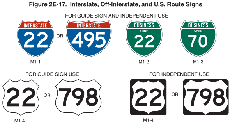
03 Route signs and auxiliary signs showing junctions and turns should be used for guidance on approach roads, for route confirmation just beyond entrances and exits, and for reassurance along the freeway or expressway. When used along the freeway or expressway, the Route signs should be enlarged to a 36 x 36-inch minimum size for routes with one or two digits and to a 45 x 36-inch minimum size for routes with three digits as shown in the "Standard Highway Signs and Markings" book (see Section 1A.11). When independently mounted Route signs are used in place of Pull-Through signs, they should be located just beyond the exit.
Option:
04 The standard Trailblazer Assembly (see Section 2D.35) may be used on roads leading to the freeway or expressway. Component messages of the Trailblazer Assembly may be included on a single sign in accordance with the provisions of Section 2D.12. Independently mounted Route signs may be used instead of Pull-Through signs (see Section 2E.12) as confirmation information.
Support:
05 Section 2H.07 contains information regarding the design of signs for Auto Tour Routes.
Option:
06 The commonly used name or trailblazer route sign for a toll highway (see Chapter 2F) may be displayed on non-toll sections of the Interstate Highway System at:
- The last exit before entering a toll section of the Interstate Highway System;
- The interchange or connection with a toll highway, whether or not the toll highway is a part of the Interstate Highway System; and
- Other locations within a reasonable approach distance of toll highways when the name or trailblazer symbol for the toll highway would provide better guidance to road users unfamiliar with the area than would place names and route numbers.
07 The toll highway name or route sign may be included as a part of the guide sign installations on intersecting highways and approach roads to indicate the interchange with a toll section of an Interstate route. Where needed for the proper direction of traffic, a trailblazer for a toll highway that is part of the Interstate Highway System may be displayed with the Interstate Trailblazer Assembly.
Support:
08 Chapter 2F contains additional information regarding signing for toll highways.
Section 2E.28 Eisenhower Interstate System Signs (M1-10, M1-10a)
Option:
01 The Eisenhower Interstate System (M1-10 and M1-10a) signs (see Figure 2E-18) may be used on Interstate highways at periodic intervals and in rest areas, scenic overlooks, or other similar roadside facilities on the Interstate Highway System.
Figure 2E-18 Eisenhower Interstate System Signs
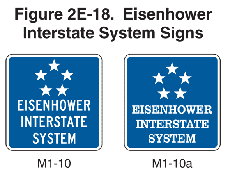
Guidance:
02 If used, the M1-10a sign should be used only in rest areas or other similar facilities where the sign can be viewed by occupants of parked vehicles or by pedestrians. The M1-10a sign should not be installed on Interstate highway mainlines, ramps, or other roadways where it can be viewed by vehicular traffic.
Standard:
03 The M1-10 and M1-10a signs shall not be used as part of a Junction, Advance Route Turn, Directional, or Trailblazer Assembly or as part of a guide sign or similar assembly providing direction to a route or destination.
Section 2E.29 Signs for Intersections at Grade
Guidance:
01 If there are intersections at grade within the limits of an expressway, guide sign types provided in Chapter 2D should be used. However, such signs should be of a size compatible with the size of other signing on the expressway.
Option:
02 Advance Guide signs for intersections at grade may take the form of diagrammatic layouts depicting the geometrics of the intersection along with essential directional information.
Section 2E.30 Interchange Guide Signs
Standard:
01 The signs at interchanges and on their approaches shall include Advance Guide signs and Exit Direction signs. Consistent destination messages shall be displayed on these signs.
Guidance:
02 New destination information should not be introduced into the major sign sequence for one interchange, nor should destination information be dropped.
03 Reference should be made to Section 2E.11 and Sections 2E.33 through 2E.42 for a detailed description of the signs in the order that they should appear at the approach to and beyond each interchange. Guide signs placed in advance of an interchange deceleration lane should be spaced at least 800 feet apart.
04 Supplemental guide signing should be used sparingly as provided in Section 2E.35.
Section 2E.31 Interchange Exit Numbering
Support:
01 Interchange exit numbering provides valuable orientation for the road user on a freeway or expressway. The feasibility of numbering interchanges or exits on an expressway will depend largely on the extent to which grade separations are provided. Where there is appreciable continuity of interchange facilities, interrupted only by an occasional intersection at grade, the numbering will be helpful to the expressway user.
Standard:
02 Interchange numbering shall be used in signing each freeway interchange exit. Interchange exit numbers shall be displayed with each Advance Guide sign, Exit Direction sign, and Exit Gore sign. The exit number shall be displayed on a separate plaque at the top of the Advance Guide or Exit Direction sign. The exit number (E1-5P) plaque (see Figure 2E-22) shall be 30 inches in height and shall include the word EXIT and the appropriate exit number in a single-line format. Suffix letters shall be used for exit numbering at a multi-exit interchange. The suffix letter shall also be included on the exit number plaque and shall be separated from the exit number by a space having a width of between 1/2 and 3/4 of the height of the suffix letter. Exit numbers shall not include the cardinal initials corresponding to the directions of the cross route. Minimum numeral and letter sizes are given in Tables 2E-2 through 2E-5. If used, the interchange numbering system for expressways shall comply with the provisions prescribed for freeways.
03 At a multi-exit interchange where suffix letters are used for exit numbering, an exit of the same number without a suffix letter shall not be used on the same route in the same direction. For example, if an exit is designated as EXIT 256 A, then there shall not be an exit designated as EXIT 256 on the same route in the same direction.
04 Interchange exit numbering shall use the reference location sign exit numbering method. The consecutive exit numbering method shall not be used.
Support:
05 Reference location sign exit numbering assists road users in determining their destination distances and travel mileage, and assists highway agencies because the exit numbering sequence does not have to be changed if new interchanges are added to a route.
Option:
06 Exit numbers may also be used with Supplemental Guide signs and Motorist Service signs.
Guidance:
07 Exit number (E1-5P) plaques should be added to the top right-hand edge of the sign for an exit to the right.
Standard:
08 Because road users might not expect an exit to the left and might have difficulty in maneuvering to the left, a left exit number (E1-5bP) plaque (see Figure 2E-22) shall be added to the top left-hand edge of the sign for all left-hand exits (see Figures 2E-14 and 2E-15). The word LEFT on the E1-5bP plaque shall be a black legend on a yellow rectangular sign panel and shall be centered above the word EXIT.
Support:
09 Example exit number plaque designs are shown in Figure 2E-22. Figures 2E-3, 2E-7, 2E-22, 2E-26, and 2E-27 illustrate the incorporation of exit number plaques on guide signs.
10 The general plan for numbering interchange exits is shown in Figures 2E-19 through 2E-21. Figure 2E-19 shows a circumferential route, which is a route that makes a complete circle around a city or town and usually has two interchanges (one on each side of the city or town) with each of the mainline routes that travel through the city or town. Figure 2E-20 shows a loop route, which is a route that departs from a mainline route and then rejoins the same mainline route at a subsequent point downstream, and a spur route, which is a route that departs from a mainline route and never rejoins the same mainline route. Figure 2E-21 shows two mainline routes that overlap each other.
Figure 2E-19 Example of Interchange Numbering for Mainline and Circumferential Routes
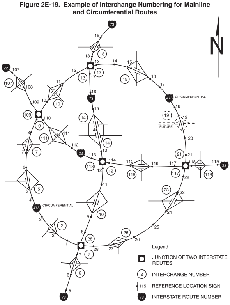
Figure 2E-20 Example of Interchange Numbering for Mainline, Loop, and Spur Routes
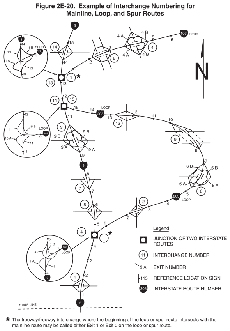
Figure 2E-21 Example of Interchange Numbering for Overlapping Routes
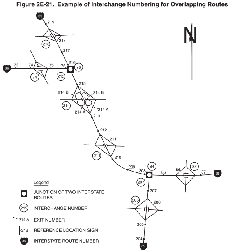
Standard:
11 Regardless of whether a mainline route originates within a State or crosses into a State from another State, the southernmost or westernmost terminus within that State shall be the beginning point for interchange numbering.
12 For circumferential routes, interchange numbering shall be in a clockwise direction. The numbering shall begin with the first interchange west of the south end of an imaginary north-south line bisecting the circumferential route, at a radial freeway or other Interstate route, or some other conspicuous landmark in the circumferential route near a south polar location (see Figure 2E-19).
13 The interchange numbers on loop routes shall begin at the loop interchange nearest the south or west mainline junction and increase in magnitude toward the north or east mainline junction (see Figure 2E-20).
14 Spur route interchanges shall be numbered in ascending order starting at the interchange where the spur leaves the mainline route (see Figure 2E-20).
15 If a circumferential, loop, or spur route crosses State boundaries, the numbering sequence shall be coordinated by the States to provide continuous interchange numbering.
16 Where numbered routes overlap, continuity of interchange numbering shall be established for only one of the routes (see Figure 2E-21). If one of the routes is an Interstate and the other route is not an Interstate, the Interstate route shall maintain continuity of interchange numbering.
Guidance:
17 The route chosen for continuity of interchange numbering should also have reference location sign continuity (see Figure 2E-21).
Section 2E.32 Interchange Classification
Support:
01 For signing purposes, interchanges are classified as major, intermediate, and minor. The minimum alphabet sizes contained in Tables 2E-2 and 2E-4 are based on this classification. Descriptions of these classifications are as follows:
- Major interchanges are subdivided into two categories: (a) interchanges with other expressways or freeways, or (b) interchanges with high-volume multi-lane highways, principal urban arterials, or major rural routes where the volume of interchanging traffic is heavy or includes many road users unfamiliar with the area.
- Intermediate interchanges are those with urban and rural routes not in the category of major or minor interchanges.
- Minor interchanges include those where traffic is local and very light, such as interchanges with land service access roads. Where the sum of exit volumes is estimated to be lower than 100 vehicles per day in the design year, the interchange is classified as minor.
Section 2E.33 Advance Guide Signs
Support:
01 An Advance Guide sign (see Figure 2E-22) gives notice well in advance of the exit point of the principal destinations served by the next interchange and the distance to that interchange.
Figure 2E-22 Examples of Interchange Advance Guide Signs, Exit Number Plaques, and LEFT Plaque
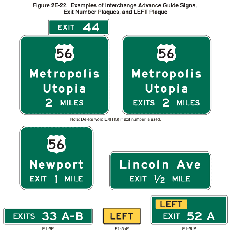
Guidance:
02 For major and intermediate interchanges (see Section 2E.32), Advance Guide signs should be placed at 1/2 mile and at 1 mile in advance of the exit with a third Advance Guide sign placed at 2 miles in advance of the exit if spacing permits. At minor interchanges, only one Advance Guide sign should be used. It should be located 1/2 to 1 mile from the exit gore. If the sign is located less than 1/2 mile from the exit, the distance displayed should be to the nearest 1/4 mile. Fractions of a mile, rather than decimals, should be displayed in all cases.
Standard:
03 For numbered exits to the left, a left exit number (E1-5bP) plaque (see Figure 2E-22) shall be added to the top left-hand edge of the sign.
04 For non-numbered exits to the left, a LEFT (E1-5aP) plaque (see Figure 2E-22) shall be added to the top left-hand edge of the sign.
Support:
05 Section 2E.31 contains additional information regarding exit numbering.
Standard:
06 Advance Guide signs for multi-lane exits having an optional exit lane that also carries the through route (see Figures 2E-4, 2E-5, 2E-8, and 2E-9) and for splits with an option lane (see Figures 2E-6 and 2E-10) shall be Overhead Arrow-per-Lane or diagrammatic signs designed in accordance with Sections 2E.20 through 2E.22.
07 Except as provided in Section 2E.24, Advance Guide signs, if used, shall contain the distance message. Except as provided in Paragraph 8 of this Section, the legend on the Advance Guide signs shall be the same as the legend on the Exit Direction sign, except that the last line shall read EXIT XX MILES. If the interchange has two or more exit roadways, the bottom line shall read EXITS XX MILES.
Guidance:
08 Where interchange exit numbers are used, the word EXIT(S) should be omitted from the bottom line.
Option:
09 Where the distance between interchanges is more than 1 mile, but less than 2 miles, the first Advance Guide sign may be closer than 2 miles, but not placed so as to overlap the signing for the previous exit. Duplicate Advance Guide signs or Interchange Sequence Series signs may be placed in the median on the opposite side of the roadway and are not included in the minimum requirements of interchange signing.
Guidance:
10 Where there is less than 800 feet between interchanges, Interchange Sequence Series signs (see Section 2E.40) should be used instead of Advance Guide signs for the affected interchanges.
11 The Advance Guide signs for the last exit from a highway before it becomes a facility on which toll payments are required should include the LAST EXIT BEFORE TOLL (W16-16P) plaque (see Section 2F.10 and Figure 2F-3). The plaque should be installed above the Advance Guide signs.
Option:
12 If there is insufficient space above the Advance Guide sign because of the presence of an exit number plaque, the W16-16P plaque may be installed below the Advance Guide sign.
Section 2E.34 Next Exit Plaques
Option:
01 Where the distance to the next interchange is unusually long, a Next Exit plaque (see Figure 2E-23) may be installed to inform road users of the distance to the next interchange.
Figure 2E-23 Next Exit Plaques

Guidance:
02 The Next Exit plaque should not be used unless the distance between successive interchanges is more than 5 miles.
Standard:
03 The Next Exit plaque shall carry the legend NEXT EXIT XX MILES. If the Next Exit plaque is used, it shall be placed below the Advance Guide sign nearest the interchange. It shall be mounted so as to not adversely affect the breakaway feature of the sign support structure.
Option:
04 The legend for the Next Exit plaque may be displayed in either one or two lines as shown in Figure 2E-23.
Support:
05 The one-line message on the Next Exit plaque is the more desirable choice unless the message causes the sign to have a horizontal dimension greater than that of the Advance Guide sign.
Section 2E.35 Other Supplemental Guide Signs
Support:
01 Supplemental Guide signs can be used to provide information regarding destinations accessible from an interchange, other than places displayed on the standard interchange signing. However, such Supplemental Guide signing can reduce the effectiveness of other more important guide signing because of the possibility of overloading the road user's capacity to receive visual messages and make appropriate decisions. "The AASHTO Guidelines for the Selection of Supplemental Guide Signs for Traffic Generators Adjacent to Freeways" is incorporated by reference in this section (see Page i for AASHTO's address).
Guidance:
02 No more than one Supplemental Guide sign should be used on each interchange approach.
03 A Supplemental Guide sign (see Figure 2E-24) should not list more than two destinations. Destination names should be followed by the interchange number (and suffix), or if interchanges are not numbered, by the legend NEXT RIGHT or SECOND RIGHT or both, as appropriate. The Supplemental Guide sign should be installed as an independent guide sign assembly.
Figure 2E-24 Supplemental Guide Sign for a Multi-Exit Interchange
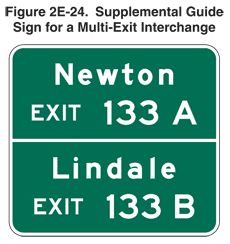
04 Where two or more Advance Guide signs are used, the Supplemental Guide sign should be installed approximately midway between two of the Advance Guide signs. If only one Advance Guide sign is used, the Supplemental Guide sign should follow it by at least 800 feet. If the interchanges are numbered, the interchange number should be used for the action message.
05 States and other agencies should adopt an appropriate policy for installing supplemental signs using "The AASHTO Guidelines for the Selection of Supplemental Guide Signs for Traffic Generators Adjacent to Freeways." In developing policies for such signing, such items as population, amount of traffic generated, distance from the route, and the significance of the destination should be taken into account.
Standard:
06 Guide signs directing drivers to park – ride facilities shall be considered as Supplemental Guide signs (see Figure 2E-25).
Figure 2E-25 Supplemental Guide Sign for a Park – Ride Facility

Option:
07 A pictograph (see definition in Section 1A.13) may be used on a Supplemental Guide sign in conjunction with a destination that is associated with governmental agencies, military bases, universities, or other government-approved institutions.
Standard:
08 The maximum dimension (height or width) of a pictograph shall not exceed two times the upper-case letter height of the destination legend and shall not exceed the size of a route shield on the guide sign. If used, the pictograph shall be located to the left of the destination legend it represents, except as provided in Paragraph 9 for the park-ride Supplemental Guide sign.
09 When a transit pictograph is displayed on the park-ride Supplemental Guide sign, it shall be located on the same line as the carpool symbol, if used, above the word legend.
10 A pictograph representing a State, county, or municipal corporation or other incorporated or unincorporated community shall not be displayed on a Supplemental Guide sign.
11 Pictographs shall otherwise comply with the provisions of Section 2A.06.
Section 2E.36 Exit Direction Signs
Support:
01 The Exit Direction sign (see Figure 2E-26) repeats the route and destination information that was displayed on the Advance Guide sign(s) for the next exit, and thereby assures road users of the destination served and indicates whether they exit to the right or left for that destination.
Figure 2E-26 Examples of Interchange Exit Direction Signs
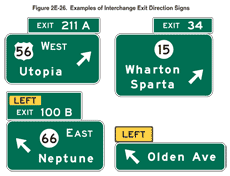
Standard:
02 Exit Direction signs shall be used at major and intermediate interchanges. Populations or other similar information shall not be displayed on Exit Direction signs.
Guidance:
03 Exit Direction signs should be used at minor interchanges.
04 Post-mounted Exit Direction signs should be installed at the beginning of the deceleration lane. If there is less than 300 feet from the upstream end of the deceleration lane to the theoretical gore (see Figure 3B-8), the Exit Direction sign should be installed overhead over the exiting lane in the vicinity of the theoretical gore.
Standard:
05 Except where Overhead Arrow-per-Lane guide signs are used (see Section 2E.21 and Paragraph 6 of this Section), where a through lane is being terminated (dropped) at an exit, the Exit Direction sign shall be placed overhead at the theoretical gore (see Figures 2E-8 through 2E-11, and 2E-14 through 2E-16).
06 Except as provided in Paragraph 4 in Section 2E.21, where Overhead Arrow-per-Lane guide signs are used for the Advance Guide sign(s) for a multi-lane exit having an optional exit lane that also carries the through route or for a split with an option lane (see Section 2E.21), an Overhead Arrow-per-Lane guide sign shall also be used instead of the Exit Direction sign. This Overhead Arrow-per-Lane guide sign shall include the appropriate exit number (E1-5P or E1-5bP) plaque (if a numbered exit) and it shall be located near, but not downstream from, the point where the outside edge of the dropped lane begins to diverge from the mainline (see Figures 2E-4 through 2E-6).
07 The following provisions shall govern the design and application of overhead Exit Direction signs:
- The sign shall carry the exit number (if exit numbering is used), the route number, cardinal direction, and destination, as applicable, with a diagonally upward-pointing directional arrow (see Figure 2E-26).
- The message EXIT ONLY in black on a yellow sign panel (E11-1d or E11-1e) shall be used on the overhead Exit Direction sign to advise road users of a lane drop situation (see Figures 2E-8 through 2E-11). The sign shall comply with the provisions of Section 2E.24.
Guidance:
08 For numbered exits to the right, an exit number (E1-5P) plaque (see Figure 2E-22) should be added to the top right-hand edge of the sign.
Standard:
09 For numbered exits to the left, a left exit number (E1-5bP) plaque (see Figure 2E-22) shall be added to the top left-hand edge of the sign.
10 For non-numbered exits to the left, a LEFT (E1-5aP) plaque (see Figure 2E-22) shall be added to the top left-hand edge of the sign.
Support:
11 Section 2E.31 contains additional information regarding exit numbering.
Option:
12 In some cases, principally in urban areas, where restricted sight distance because of structures or unusual alignment make it impossible to locate the Exit Direction sign without violating the required minimum spacing (see Section 2E.33) between major guide signs, Interchange Sequence signs (see Section 2E.40) may be substituted for an Advance Guide sign.
Guidance:
13 At multi-exit interchanges, the Exit Direction sign should be located directly over the exiting lane for the first exit. At the same location, and normally over the right-hand through lane, an Advance Guide sign for the second exit should be located. Only for those conditions where the through movement is not evident should a confirmatory message (Pull-Through sign as shown in Figure 2E-2) be used over the left lane(s) to guide road users traveling through an interchange. In the interest of sign spreading, three signs on one structure should not be used. When the freeway or expressway is on an overpass, the Exit Direction sign should be installed on an overhead support over the exit lane in advance of the gore point.
Option:
14 If the second exit is beyond an underpass, the Exit Direction sign may be mounted on the face of the overhead structure.
15 Where extra emphasis of an especially low advisory ramp speed is needed, an EXIT XX MPH (E13-2) sign panel (see Figure 2E-27) may be placed at the bottom of the Exit Direction sign to supplement, but not to replace, the exit or ramp advisory speed warning signs.
Figure 2E-27 Interchange Exit Direction Sign with an Advisory Speed Panel

Guidance:
16 At the last exit from a highway before it becomes a facility on which toll payments are required, the LAST EXIT BEFORE TOLL (W16-16P) plaque (see Section 2F.10 and Figure 2F-3) should be installed above the Exit Direction sign.
Option:
17 If there is insufficient space above the Exit Direction sign because of the presence of an Exit Number (E1-5P) plaque, the W16-16P plaque may be mounted below the Exit Direction sign.
Section 2E.37 Exit Gore Signs (E5-1 Series)
Support:
01 The Exit Gore (E5-1 or E5-1a) sign (see Figure 2E-28) in the gore indicates the exiting point or the place of departure from the main roadway. Consistent application of this sign at each exit is important.
Figure 2E-28 Exit Gore Signs
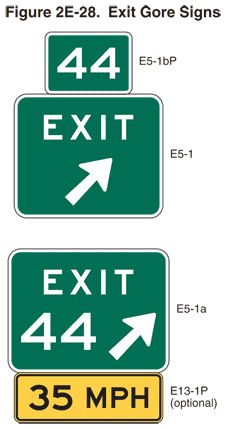
Standard:
02 The gore shall be defined as the area located between the main roadway and the ramp just beyond where the ramp branches from the main roadway. The Exit Gore sign shall be located in the gore and shall carry the word EXIT or EXIT XX (if interchange numbering is used) and an appropriate upward slanting arrow. If suffix letters are used for exit numbering at a multi-exit interchange, the suffix letter shall also be included on the Exit Gore sign and shall be separated from the exit number by a space having a width of between 1/2 and 3/4 of the height of the suffix letter. Breakaway or yielding supports shall be used.
Guidance:
03 The arrow should be aligned to approximate the angle of departure. Each gore should be treated similarly, whether the interchange has one exit roadway or multiple exits.
Option:
04 Where extra emphasis of an especially low advisory ramp speed is needed, an E13-1P plaque indicating the advisory speed may be mounted below the Exit Gore sign (see Figure 2E-28) to supplement, but not to replace, the exit or ramp advisory speed warning signs.
05 To improve the visibility of the gore for exiting drivers, a Type 1 object marker (see Chapter 2C) may be installed on each sign support below the Exit Gore sign.
06 An Exit Number (E5-1bP) plaque (see Figure 2E-22) may be installed above an existing Exit Gore (E5-1) sign when a non-numbered exit is converted to a numbered exit.
Standard:
07 An Exit Gore (E5-1a) sign shall be used when the replacement of an existing assembly of an E5-1 sign and an E5-1bP plaque becomes necessary.
Option:
08 The Narrow Exit Gore (E5-1c) sign may be used in gore areas of limited width where the width of the Exit Gore (E5-1a) sign would not permit sufficient lateral offset (see Section 2A.19), such as for ramp departures that are nearly parallel to the mainline roadway where the Exit Gore sign would be mounted on a narrow island or barrier. Where the E5-1c sign is mounted at a height of 14 feet or more from the roadway, the directional arrow may point diagonally downward.
Guidance:
09 The E5-1c should not be used in gore areas where an E5-1a sign could be installed with sufficient lateral offset.
Section 2E.38 Post-Interchange Signs
Guidance:
01 If space between interchanges permits, as in rural areas, and where undue repetition of messages will not occur, a fixed sequence of signs should be displayed beginning 500 feet beyond the downstream end of the acceleration lane. At this point a Route sign assembly should be installed followed by a Speed Limit sign and a Distance sign, each at a spacing of 1,000 feet.
02 If space between interchanges does not permit placement of these three post-interchange signs without encroaching on or overlapping the Advance Guide signs necessary for the next interchange, or in rural areas where the interchanging traffic is primarily local, one or more of the post-interchange signs should be omitted.
Option:
03 Usually the Distance sign will be of less importance than the other two signs and may be omitted, especially if Interchange Sequence signs are used. If the sign for through traffic on an overhead assembly already contains the route sign, the post-interchange route sign assembly may also be omitted.
Section 2E.39 Post-Interchange Distance Signs
Standard:
01 If used, the Post-Interchange Distance sign shall consist of a two- or three-line sign carrying the names of significant destination points and the distances to those points. The top line of the sign shall identify the next meaningful interchange with the name of the community near or through which the route passes, or if there is no community, the route number or name of the intersected highway (see Figure 2E-29).
Figure 2E-29 Post-Interchange Distance Sign
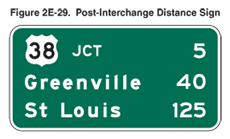
Support:
02 The minimum sizes of the route shields identifying a significant destination point are prescribed in Tables 2E-3 and 2E-5.
Option:
03 The text identification of a route may be displayed instead of a route shield, such as "US XX," "State Route XX," or "County Route XX."
Guidance:
04 If a second line is used, it should be reserved for communities of general interest that are located on or immediately adjacent to the route or for major traffic generators along the route.
Option:
05 The choice of names for the second line, if it is used, may be varied on successive Distance signs to give road users maximum information concerning communities served by the route.
Standard:
06 The third, or bottom line, shall contain the name and distance to a control city (if any) that has national significance for travelers using the route.
Guidance:
07 Distances to the same destinations should not be shown more frequently than at 5-mile intervals. The distances displayed on these signs should be the actual distance to the destination points and not to the exit from the freeway or expressway. The distance displayed for each community should comply with the provisions of Section 2D.41.
Section 2E.40 Interchange Sequence Signs
Option:
01 If interchanges are closely spaced, particularly through large urban areas, so that guide signs cannot be adequately spaced, Interchange Sequence signs identifying the next two or three interchanges may be used.
Guidance:
02 If used, Interchange Sequence signs should be used over the entire length of a route in an urban area. Except as provided in Paragraph 3, they should not be used on a single interchange basis.
03 If there is less than 800 feet between interchanges, Interchange Sequence signs should be used instead of the Advance Guide signs for the affected interchanges.
Support:
04 Interchange Sequence signs are generally supplemental to Advance Guide signs. Signing of this type is illustrated in Figures 2E-30 and 2E-31, and is compatible with the sign spreading concept described in Paragraph 3 of Section 2E.11.
Figure 2E-30 Example of Using an Interchange Sequence Sign for Closely-Spaced Interchanges
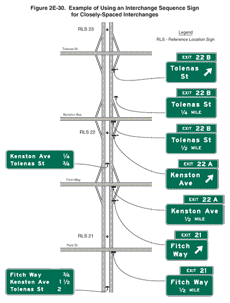
Figure 2E-31 Interchange Sequence Sign

05 These signs are installed in a series and display the next two or three interchanges by name or route number with distances to the nearest 1/4 mile.
Standard:
06 If used, the first sign in the series shall be located in advance of the first Advance Guide sign for the first interchange.
07 Where the exit direction is to the left, a LEFT (E11-2) sign panel (see Figure 2E-13) shall be displayed on the same line immediately to the right of the interchange name or route number.
08 Interchange Sequence signs shall not be substituted for Exit Direction signs.
Guidance:
09 Interchange Sequence signs should be located in the median. After the first of the series, Interchange Sequence signs should be placed approximately midway between interchanges.
Standard:
10 Interchange Sequence signs located in the median shall be installed at overhead sign height (see Section 2A.18).
Option:
11 Interchange numbers may be displayed to the left of the interchange name or route number.
Section 2E.41 Community Interchanges Identification Signs
Support:
01 For suburban or rural communities served by two or three interchanges, Community Interchanges Identification signs are useful (see Figure 2E-32).
Figure 2E-32 Community Interchanges Identification Sign
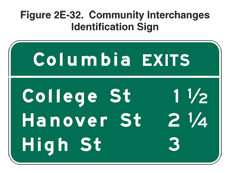
Guidance:
02 In these cases, the name of the community followed by the word Exits should be displayed on the top line; the lines below should display the destination, road name or route number, and the corresponding distances to the nearest 1/4 mile.
03 The sign should be located in advance of the first Advance Guide sign for the first interchange within the community.
Option:
04 If interchanges are not conveniently identifiable or if there are more than three interchanges to be identified, the NEXT XX EXITS sign (see Section 2E.42) may be used.
Section 2E.42 NEXT XX EXITS Sign
Support:
01 Many freeways or expressways pass through historical or recreational regions, or urban areas served by a succession of several interchanges.
Option:
02 Such regions or areas may be indicated by a NEXT XX EXITS sign (see Figure 2E-33) located in advance of the Advance Guide sign or signs for the first interchange.
Figure 2E-33 NEXT EXITS Sign
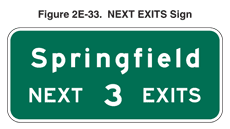
Guidance:
03 The sign legend should identify the region or area followed by the words NEXT XX EXITS.
Section 2E.43 Signing by Type of Interchange
Support:
01 Road users need signs to help identify the location of the exit, as well as to obtain route, direction, and destination information for specific exit ramps. Figures 2E-34 through 2E-40 show examples of guide signs for common types of interchanges. The interchange layouts shown in most of the figures illustrate only the major guide signs for one direction of traffic on the freeway and on the exit ramps. Section 2D.45 contains information regarding the signing of the crossroad approaches and connecting roadways to freeways and expressways.
Standard:
02 Interchange guide signing shall be consistent for each type of interchange along a route.
Guidance:
03 The signing layout for all interchanges having only one exit ramp in the direction of travel should be similar, regardless of the interchange type. For the sake of uniform application, the significant features of the signing plan for each of the more frequent kinds of interchanges (illustrated in Figures 2E-34 through 2E-40) should be followed as closely as possible. Even when unusual geometric features exist, variations in signing layout should be held to a minimum.
Section 2E.44 Freeway-to-Freeway Interchange
Support:
01 Freeway-to-freeway interchanges are major decision points where the effect of taking a wrong ramp cannot be easily corrected. Reversing direction on the connecting freeway or reentering to continue on the intended course is usually not possible. Figure 2E-34 shows examples of guide signs at a freeway-to-freeway interchange.
Figure 2E-34 Examples of Guide Signs for a Freeway-to-Freeway Interchange
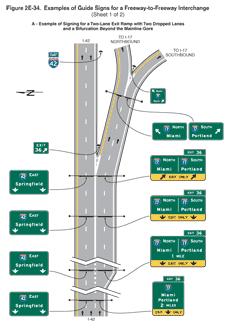
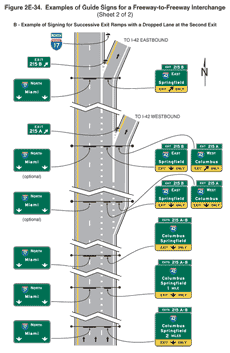
Guidance:
02 The sign messages should contain only the route shield, cardinal direction, and the name of the next control city on the route. Arrows should point as indicated in Section 2D.08, except where Overhead Arrow-per-Lane or Diagrammatic signs are used in accordance with the provisions of Sections 2E.20 through 2E.22.
Support:
03 At splits where the off-route movement is to the left or where there is an optional lane split, expectancy problems usually result.
Standard:
04 At splits where the off-route movement is to the left, the Left Exit Number (E1-5bP) plaque shall be added at the top left-hand edge of the guide sign (see Section 2E.31). Overhead Arrow-per-Lane or Diagrammatic guide signs (see Sections 2E.21 and 2E.22) shall be used for freeway splits with an option lane and for multi-lane freeway-to-freeway exits having an option lane.
05 Overhead signs shall be used at a distance of 1 mile and at the theoretical gore of each connecting ramp. When Overhead Arrow-per-Lane or Diagrammatic guide signs are used, they shall comply with the provisions of Sections 2E.21 and 2E.22.
Option:
06 Overhead signs may also be used at the 1/2-mile and 2-mile locations.
07 The arrow and/or the name of the control city may be omitted on signs that indicate the straight-ahead continuation of a route on a Pull-Through sign (see Section 2E.12).
08 An Advisory Exit Speed sign may be used where an engineering study shows that it is necessary to display a speed reduction message for ramp signing (see Section 2C.14).
09 Where extra emphasis of an especially low advisory ramp speed is needed, an EXIT XX MPH (E13-2) sign panel (see Figure 2E-27) may be placed at the bottom of the Exit Direction sign to supplement, but not to replace, the exit or ramp advisory speed warning signs.
Section 2E.45 Cloverleaf Interchange
Support:
01 A cloverleaf interchange has two exits for each direction of travel. The exits are closely spaced and have common Advance Guide signs. Examples of guide signs for cloverleaf interchanges are shown in Figure 2E-35.
Figure 2E-35 Examples of Guide Signs for a Full Cloverleaf Interchange
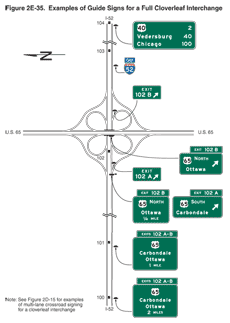
Guidance:
02 The Advance Guide signs should include two place names, one corresponding to each exit ramp, with the name of the place served by the first exit on the upper line.
Standard:
03 An overhead guide sign shall be placed at the theoretical gore of the first exit ramp, with a diagonally upward-pointing directional arrow on the Exit Direction sign for that exit and the message XX MILES, or EXIT XX MILES if interchange numbering is not used, on the Advance Guide sign for the second exit, as shown in Figure 2E-35. The second exit shall be indicated by an overhead Exit Direction sign over the auxiliary lane. An Exit Gore sign shall also be used at each gore (see Section 2E.37).
04 Interchanges with more than one exit from the main line shall be numbered as described in Section 2E.31 with an appropriate suffix.
05 Diagrammatic signs shall not be used for cloverleaf interchanges except as otherwise provided in Section 2E.22.
Guidance:
06 Where the mainline passes under the crossroad and the exit roadway is located beyond the overcrossing structure, the overhead Exit Direction sign for the second exit should be placed either on the overcrossing structure (see Figure 2E-35) or on a separate structure located immediately in front of the overcrossing structure.
Section 2E.46 Cloverleaf Interchange with Collector-Distributor Roadways
Support:
01 Examples of guide signs for full cloverleaf interchanges with collector-distributor roadways are shown in Figure 2E-36.
Figure 2E-36 Examples of Guide Signs for a Full Cloverleaf Interchange with Collector-Distributor Roadways
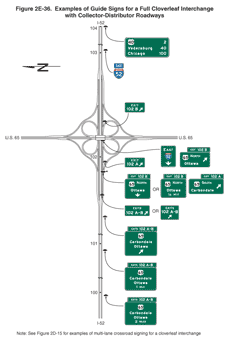
Guidance:
02 Signing on the collector-distributor roadways should be the same as the signing on the mainline of a cloverleaf interchange.
Standard:
03 Guide signs at exits from the collector-distributor roadways shall be overhead and located at the theoretical gore of the collector-distributor roadway and the exit ramp.
Option:
04 Exits from the collector-distributor roadways may be numbered with an appropriate suffix. If the exits from a collector-distributor roadway are numbered with suffixes, the Advance Guide signs on the mainline may include two place names and their corresponding exit numbers with the plural EXITS. If only the exit from the mainline is numbered or if interchange numbering is not used, the Advance Guide signs on the mainline may use the singular EXIT.
Section 2E.47 Partial Cloverleaf Interchange
Support:
01 Examples of guide signs for partial cloverleaf interchanges are shown in Figure 2E-37.
Figure 2E-37 Examples of Guide Signs for a Partial Cloverleaf Interchange
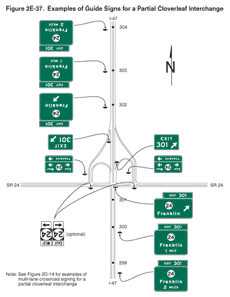
Guidance:
02 Where the mainline passes under the crossroad and the exit roadway is located beyond the overcrossing structure, the overhead Exit Direction sign should be placed either on the overcrossing structure (see Figure 2E-37) or on a separate structure located immediately in front of the overcrossing structure.
Standard:
03 A post-mounted Exit Gore sign shall also be installed in the ramp gore.
Support:
04 Partial cloverleaf interchanges with successive exit ramps from the same direction of travel are signed the same as cloverleaf interchanges for that direction of travel (see Section 2E.45).
Section 2E.48 Diamond Interchange
Support:
01 Examples of guide signs for diamond interchanges are shown in Figure 2E-38.
Figure 2E-38 Examples of Guide Signs for a Diamond Interchange
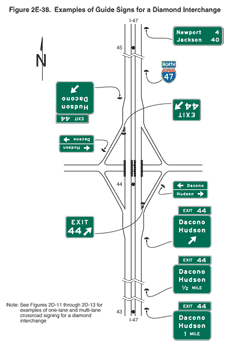
Standard:
02 For numbered exits, the singular message EXIT shall be used on the Exit Number plaques (see Section 2E.31) with the Advance Guide and Exit Direction signs. For non-numbered exits, the singular message EXIT shall be used as part of the distance message on the Advance Guide signs.
Support:
03 The typical diamond interchange ramp departs from the mainline roadway such that a speed reduction generally is not necessary in order for a driver to negotiate an exit maneuver from the mainline onto the ramp roadway.
Guidance:
04 When a speed reduction is not necessary, an exit speed sign should not be used.
Option:
05 An Advisory Exit Speed sign may be used where an engineering study shows that it is necessary to display a speed reduction message for ramp signing (see Section 2C.14).
Guidance:
06 The Advisory Exit Speed sign should be located along the deceleration lane or along the ramp such that it is visible to the driver far enough in advance to allow the driver to decelerate before reaching the curve associated with the exiting maneuver.
Option:
07 A Stop Ahead or Signal Ahead warning sign may be placed, where engineering judgment indicates a need, along the ramp in advance of the cross street, to give notice to the driver (see Section 2C.36).
Guidance:
08 When used on two-lane ramps, Stop Ahead or Signal Ahead signs should be used in pairs with one sign on each side of the ramp.
Section 2E.49 Diamond Interchange in Urban Area
Support:
01 Examples of guide signs for diamond interchanges in an urban area are shown in Figure 2E-39. This example includes the use of the Community Interchanges Identification sign (see Section 2E.41), which might be useful if two or more interchanges serve the same community.
Figure 2E-39 Examples of Guide Signs for a Diamond Interchange in an Urban Area
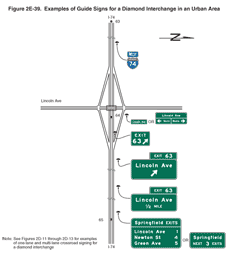
02 In urban areas, street names are often displayed as the principal message in destination signs.
Option:
03 If interchanges are too closely spaced to properly locate the Advance Guide signs, they may be placed closer to the exit with the distances displayed adjusted accordingly.
Section 2E.50 Closely-Spaced Interchanges
Support:
01 Section 2E.11 contains information regarding sign spreading where the Exit Direction sign and the Advance Guide sign for the next interchange are mounted overhead. Sign spreading is particularly beneficial where interchanges are closely spaced and overhead signing is used in conjunction with Interchange Sequence signs as provided in Paragraph 2.
Guidance:
02 Interchange Sequence signs (see Section 2E.40) should be used at closely-spaced interchanges. When used, they should identify and show street names and distances for the next two or three exits as shown in Figure 2E-30.
Standard:
03 Advance Guide signs for closely-spaced interchanges shall show information for only one interchange.
Section 2E.51 Minor Interchange
Option:
01 Less signing may be used for minor interchanges because such interchanges customarily serve low volumes of local traffic.
Support:
02 Examples of guide signs for minor interchanges are shown in Figure 2E-40.
Figure 2E-40 Examples of Guide Signs for a Minor Interchange
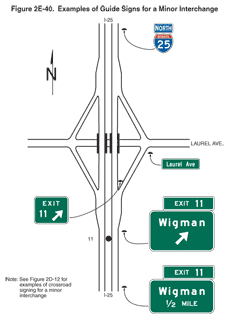
Standard:
03 At least one Advance Guide sign and an Exit Gore sign shall be used at a minor interchange.
Guidance:
04 An Exit Direction sign should also be used.
Section 2E.52 Signing on Conventional Road Approaches and Connecting Roadways
Support:
01 Section 2D.45 contains information regarding the signing on conventional roads on the approaches to interchanges and the signing on connecting roadways.
Section 2E.53 Wrong-Way Traffic Control at Interchange Ramps
Support:
01 Section 2B.41 contains information regarding the use of regulatory signs to deter wrong-way movements at intersections of freeway or expressway ramps with conventional roads, and in the area where entrance ramps intersect with the mainline lanes.
02 Section 2D.46 contains information regarding the use of a Directional assembly or a guide sign to mark the entrance to a freeway or expressway from a conventional road.
Section 2E.54 Weigh Station Signing
Standard:
01 Weigh Station signing on freeways and expressways shall be the same as that provided in Section 2D.49, except for lettering size and the advance posting distance for the Exit Direction sign, which shall be located a minimum of 1,500 feet in advance of the gore.
Support:
02 Weigh Station sign layouts for freeway and expressway applications are shown in the "Standard Highway Signs and Markings" book (see Section 1A.11).
